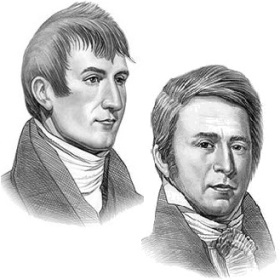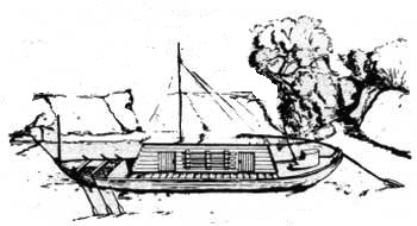|
|
|
|
|
|
4. The captains cabin was situated on the after deck and contained two bunk-beds, a bench, a desk and shelves for books and scientific instruments. 5. The hold of the keel boat was partially covered by a boxlike structure that sheltered both the cargo and the crew's sleeping space. 6. The 55 foot Keel boat could be sailed, rowed, poled like a raft, or towed by ropes from the riverbank. One of the major advantages of the keelboat was that it was able to travel both upstream and for swiftly downstream. 7. A small 1.5 inch bore cannon, or swivel gun, was mounted on the bow of the Lewis and Clark keelboat. 8. The keel boat also had a large-bore shotgun, called a blunderbuss, on a swivel guide was mounted on the stern of the keelboat. The pirogues each had a blunderbuss mounted on its bow. 9. The Lewis and Clark keelboat featured a "Commander's Pennant" on the stern as well as an American flag hoisted to the top of the mast. 10. Storage lockers built into the side of the hull. The lids could be raised for additional protection in case of attack from shore. 11. The men of the Corps of Discovery were responsible for daily task of moving the heavy boat up the Missouri River. This arduous work involved rowing, pulling the keel boat through shallows using a rope from on shore (called cordelling) or pushing the heavy boat with long poles (called poling) 12. In the spring of 1804, after wintering at Fort Mandan, a few members of the Lewis and Clark expedition were selected to return the keelboat, loaded with plant and animal specimens to provide reports of the journey to President Thomas Jefferson. 13. The return trip of the keelboat, headed by Corporal Warfington, from Fort Mandan to St. Louis was completed in just 43 days. |
| Mobile Website Menu |
|
|
|
Published 2015 |
Modified 2018 |


